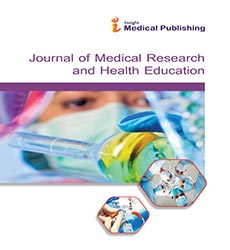Integrating Evidence-Based Medicine into Health Professional Curricula
Natasha Syed*
Department of Biomedical Sciences, University of Milan, Via della Commenda 10, 20122 Milan, Italy
*Corresponding author:
Natasha Syed,
Department of Biomedical Sciences, University of Milan, Via della Commenda 10, 20122 Milan, Italy,
E-mail: Syed.natas@unimi.it
Received date: February 03, 2025, Manuscript No. ipjmrhe-25-20728; Editor assigned date: February 05, 2025, PreQC No. ipjmrhe-25-20728 (PQ); Reviewed date: February 10, 25, QC No. ipjmrhe-25-20728; Revised date: February 17, 2025, Manuscript No. ipjmrhe-25-20728 (R); Published date: February 24, 2025, DOI: 10.36648/2393-8862.9.1.02
Citation: Syed N (2025) Integrating Evidence-Based Medicine into Health Professional Curricula. J Med Res Health Educ Vol. 9 No.1:02
Introduction
Evidence-Based Medicine (EBM) is the conscientious, explicit and judicious use of current best evidence in making decisions about the care of individual patients. It combines clinical expertise, patient values and the best available research evidence to optimize patient outcomes. In the modern healthcare environment, characterized by rapid scientific advancement and complex clinical challenges, integrating EBM into health professional education is essential. Training future physicians, nurses, pharmacists and allied health professionals in EBM equips them with critical thinking, analytical skills and the ability to apply research evidence to clinical practice. Despite widespread acknowledgment of its importance, the incorporation of EBM into health professional curricula faces challenges such as limited faculty expertise, curriculum overload, variable student engagement and a lack of standardized teaching methodologies. Nevertheless, integrating EBM effectively fosters lifelong learning, enhances clinical decision-making and bridges the gap between research and practice [1].
Description
The foundation of EBM education involves understanding the core principles of evidence appraisal, critical thinking and research methodology. Health professional students must be trained to formulate answerable clinical questions using structured frameworks such as PICO (Population, Intervention, Comparison and Outcome). This structured approach guides the search for relevant literature and facilitates the application of evidence to individual patient contexts. Curriculum design should emphasize both the acquisition of foundational knowledge in biostatistics, epidemiology and research methodology, as well as practical skills in literature search, critical appraisal and evidence synthesis. Early exposure to EBM principles, integrated longitudinally throughout the educational program, promotes familiarity and encourages habitual application in clinical reasoning [2].
Active learning strategies are central to effective EBM education. Traditional didactic lectures, while useful for introducing theoretical concepts, are insufficient to instill practical skills. Case-based learning allows students to engage with real-world clinical scenarios, requiring them to identify relevant evidence, assess its quality and apply it to patient care decisions. Problem-Based Learning (PBL) fosters collaborative inquiry, critical thinking and evidence integration, while journal clubs provide opportunities for students to critically evaluate recent research and discuss its clinical relevance.
Simulation exercises, clinical rotations and supervised research projects allow students to practice EBM skills in controlled, authentic environments, reinforcing knowledge retention and confidence in decision-making. The integration of technology enhances the teaching and application of EBM. Access to online databases, digital libraries and point-of-care tools facilitates rapid retrieval of high-quality evidence. Electronic health records (EHRs) and clinical decision support systems can be used in educational settings to demonstrate the practical application of evidence in patient care. Interactive software, mobile applications and online modules provide flexible learning platforms, allowing students to engage with evidence appraisal exercises, quizzes and guided research projects at their own pace. Leveraging technology not only improves accessibility to evidence but also familiarizes students with tools they will encounter in modern clinical practice [1].
Faculty development is a critical component of successful EBM curriculum integration. Educators must possess both content knowledge and pedagogical skills to teach evidence appraisal, research methods and critical thinking effectively. Training programs for faculty should emphasize EBM principles, instructional strategies and assessment techniques [2]. Mentorship and role modeling by faculty who exemplify evidence-based clinical practice inspire students to value and adopt EBM in their own practice. Faculty collaboration across disciplines fosters a multidisciplinary approach to teaching EBM, reflecting the collaborative nature of modern healthcare. Assessment of EBM competencies is essential for ensuring students acquire the necessary knowledge and skills.
Traditional written examinations may test theoretical understanding, but practical assessments, such as Objective Structured Clinical Examinations (OSCEs), portfolio assessments and project-based evaluations, are more effective in evaluating application skills. Assessments should measure studentsâ?? ability to formulate clinical questions, conduct literature searches, critically appraise evidence, interpret statistical results and integrate findings into patient-centered care plans. Continuous feedback during clinical rotations and research projects reinforces learning and identifies areas for improvement.
Conclusion
Integrating Evidence-Based Medicine into health professional curricula is essential for preparing clinicians capable of delivering high-quality, patient-centered care. By fostering critical thinking, research literacy and application of current best evidence, EBM education bridges the gap between theory and practice. Effective integration requires structured curricula, active learning strategies, technological support, faculty development, longitudinal embedding and culturally relevant content and robust assessment methods.
Overcoming implementation challenges and promoting a culture of lifelong learning ensures that future healthcare professionals remain adept at interpreting evidence, making informed clinical decisions and improving patient outcomes. As healthcare continues to evolve, the systematic incorporation of EBM into health professional education strengthens the foundation for competent,reflective and evidence-driven practitioners capable of meeting the complex demands of modern medicine.
Acknowledgement
None.
Conflict of Interest
None.
References
- Dawson MA, Kouzarides T, Huntly BJ (2012) Targeting epigenetic readers in cancer. N Engl J Med 367: 647-657.
Google Scholar Cross Ref Indexed at
- Florence B, Faller DV (2001) You bet-cha: A novel family of transcriptional regulators. Front Biosci 6: 1008-
Open Access Journals
- Aquaculture & Veterinary Science
- Chemistry & Chemical Sciences
- Clinical Sciences
- Engineering
- General Science
- Genetics & Molecular Biology
- Health Care & Nursing
- Immunology & Microbiology
- Materials Science
- Mathematics & Physics
- Medical Sciences
- Neurology & Psychiatry
- Oncology & Cancer Science
- Pharmaceutical Sciences
